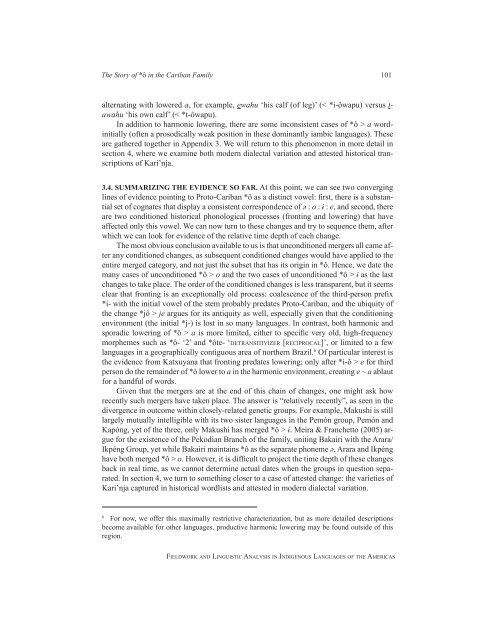Fieldwork and Linguistic Analysis in Indigenous ... - ScholarSpace
Fieldwork and Linguistic Analysis in Indigenous ... - ScholarSpace
Fieldwork and Linguistic Analysis in Indigenous ... - ScholarSpace
You also want an ePaper? Increase the reach of your titles
YUMPU automatically turns print PDFs into web optimized ePapers that Google loves.
The Story of *ȏ <strong>in</strong> the Cariban Family 101<br />
alternat<strong>in</strong>g with lowered a, for example, ewahu ‘his calf (of leg)’ (< *i-ôwapu) versus tawahu<br />
‘his own calf’ (< *t-ôwapu).<br />
In addition to harmonic lower<strong>in</strong>g, there are some <strong>in</strong>consistent cases of *ô > a word<strong>in</strong>itially<br />
(often a prosodically weak position <strong>in</strong> these dom<strong>in</strong>antly iambic languages). These<br />
are gathered together <strong>in</strong> Appendix 3. We will return to this phenomenon <strong>in</strong> more detail <strong>in</strong><br />
section 4, where we exam<strong>in</strong>e both modern dialectal variation <strong>and</strong> attested historical transcriptions<br />
of Kari’nja.<br />
3.4. SUMMARIZING THE EVIDENCE SO FAR. At this po<strong>in</strong>t, we can see two converg<strong>in</strong>g<br />
l<strong>in</strong>es of evidence po<strong>in</strong>t<strong>in</strong>g to Proto-Cariban *ô as a dist<strong>in</strong>ct vowel: first, there is a substantial<br />
set of cognates that display a consistent correspondence of ə : o : ɨ : e, <strong>and</strong> second, there<br />
are two conditioned historical phonological processes (front<strong>in</strong>g <strong>and</strong> lower<strong>in</strong>g) that have<br />
affected only this vowel. We can now turn to these changes <strong>and</strong> try to sequence them, after<br />
which we can look for evidence of the relative time depth of each change.<br />
The most obvious conclusion available to us is that unconditioned mergers all came after<br />
any conditioned changes, as subsequent conditioned changes would have applied to the<br />
entire merged category, <strong>and</strong> not just the subset that has its orig<strong>in</strong> <strong>in</strong> *ô. Hence, we date the<br />
many cases of unconditioned *ô > o <strong>and</strong> the two cases of unconditioned *ô > ɨ as the last<br />
changes to take place. The order of the conditioned changes is less transparent, but it seems<br />
clear that front<strong>in</strong>g is an exceptionally old process: coalescence of the third-person prefix<br />
*i- with the <strong>in</strong>itial vowel of the stem probably predates Proto-Cariban, <strong>and</strong> the ubiquity of<br />
the change *jô > je argues for its antiquity as well, especially given that the condition<strong>in</strong>g<br />
environment (the <strong>in</strong>itial *j-) is lost <strong>in</strong> so many languages. In contrast, both harmonic <strong>and</strong><br />
sporadic lower<strong>in</strong>g of *ô > a is more limited, either to specific very old, high-frequency<br />
morphemes such as *ô- ‘2’ <strong>and</strong> *ôte- ‘detransitivizer [reciProcal]’, or limited to a few<br />
languages <strong>in</strong> a geographically contiguous area of northern Brazil. 6 Of particular <strong>in</strong>terest is<br />
the evidence from Katxuyana that front<strong>in</strong>g predates lower<strong>in</strong>g; only after *i-ô > e for third<br />
person do the rema<strong>in</strong>der of *ô lower to a <strong>in</strong> the harmonic environment, creat<strong>in</strong>g e ~ a ablaut<br />
for a h<strong>and</strong>ful of words.<br />
Given that the mergers are at the end of this cha<strong>in</strong> of changes, one might ask how<br />
recently such mergers have taken place. The answer is “relatively recently”, as seen <strong>in</strong> the<br />
divergence <strong>in</strong> outcome with<strong>in</strong> closely-related genetic groups. For example, Makushi is still<br />
largely mutually <strong>in</strong>telligible with its two sister languages <strong>in</strong> the Pemón group, Pemón <strong>and</strong><br />
Kapóng, yet of the three, only Makushi has merged *ô > ɨ. Meira & Franchetto (2005) argue<br />
for the existence of the Pekodian Branch of the family, unit<strong>in</strong>g Bakairi with the Arara/<br />
Ikpéng Group, yet while Bakairi ma<strong>in</strong>ta<strong>in</strong>s *ô as the separate phoneme ə, Arara <strong>and</strong> Ikpéng<br />
have both merged *ô > o. However, it is difficult to project the time depth of these changes<br />
back <strong>in</strong> real time, as we cannot determ<strong>in</strong>e actual dates when the groups <strong>in</strong> question separated.<br />
In section 4, we turn to someth<strong>in</strong>g closer to a case of attested change: the varieties of<br />
Kari’nja captured <strong>in</strong> historical wordlists <strong>and</strong> attested <strong>in</strong> modern dialectal variation.<br />
6 For now, we offer this maximally restrictive characterization, but as more detailed descriptions<br />
become available for other languages, productive harmonic lower<strong>in</strong>g may be found outside of this<br />
region.<br />
fieldwork <strong>and</strong> l<strong>in</strong>guistic analysis <strong>in</strong> <strong>in</strong>digenous languages of the americas

















